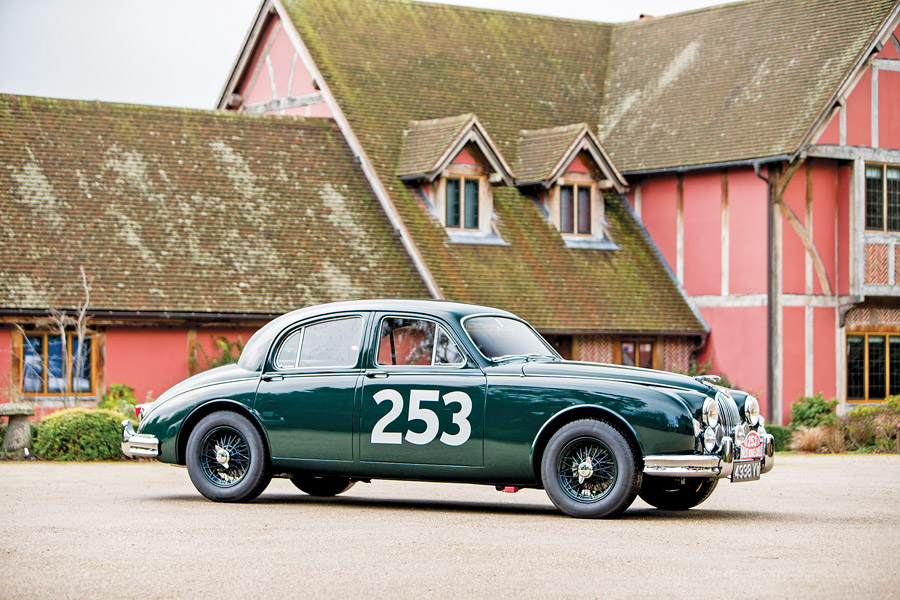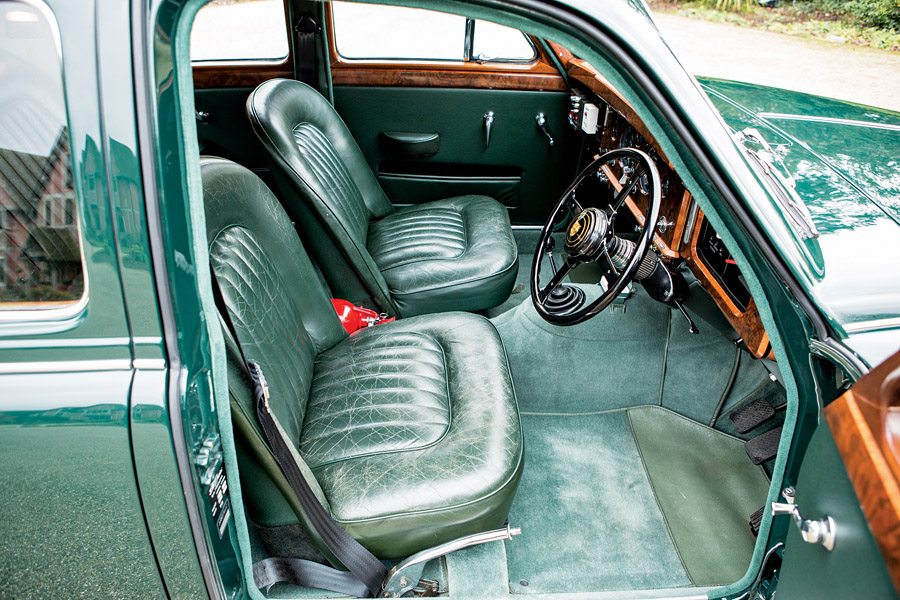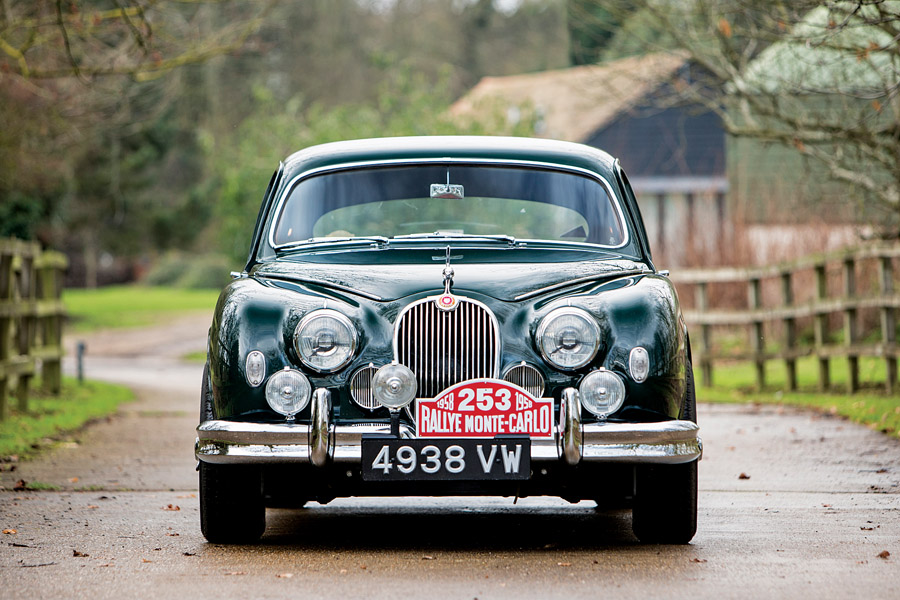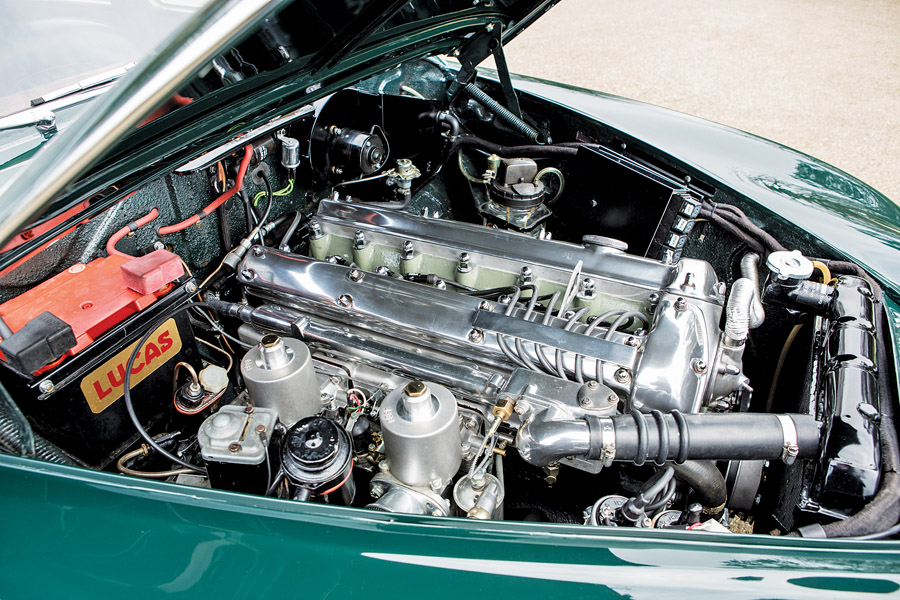SCM Analysis
Detailing
| Vehicle: | 1957 Jaguar Mk I 3.4 saloon |
| Years Produced: | 1955–59 (Mk 2 cars were made from 1959 to 1967) |
| Number Produced: | 17,405 (plus 19,992 2.4s, and about 90,000 Mk 2s) |
| Original List Price: | $4,530 |
| SCM Valuation: | $65,713 |
| Tune Up Cost: | $200 |
| Distributor Caps: | $12 (£9.17) |
| Chassis Number Location: | Plate on scuttle and stamped into bonnet catch channel forward of radiator |
| Engine Number Location: | On front of cylinder head by number one plug |
| Club Info: | Jaguar Enthusiasts’ Club |
| Website: | http://www.jec.org.uk |
| Investment Grade: | D |
This car, Lot 19, sold for $234,422 at Bonhams’ Goodwood Members’ Meeting sale on March 19, 2017.
It’s odd that Jaguar had no direct Works involvement in rallying its new 3.4-liter Saloon after it was introduced in 1955.
Jaguar won the Monte Carlo Rally outright in 1956 with a Mk VII M driven by heroic stalwart Ronnie Adams (with Frank Biggar and Derek Johnston: three-man crews were not unusual) behind the wheel.
Always a rally car
However, there was no interest in a factory team for the 3.4-liter Saloon. That said, there was no shortage of privateers willing to have a go: the Morley twins’ 3.4-liter won the Tulip Rally outright in 1959. Our subject car was ordered new by Essex-based garage owner Frank Brown, who wanted to “do the Monte” in 1958. Jaguar let him have a generous discount of 12.5%. One of his co-drivers, by the way, was Graham Arnold — yes, that Graham Arnold, later sales director of Lotus Cars and founder of Club Lotus.
Sadly, they didn’t finish due to an “off” damaging the front suspension, but the car was later sold to the other co-driver E.J. Snusher, who continued to rally it. He also used it to tow his home-built Coventry Climax-engined sports-racer, the EJS Special. So with John Young taking up the battle again in the 1980s, this has always been a competition car, which is a point in its favour — and makes it quite a rare thing.
Although these cars were extensively raced in period, if you were going to start rallying now, you wouldn’t start with one of these. I can only think of one example, a Mk 2, that’s been active in historic rallying in the past two decades.
These were never called Mk 1 in period, by the way. Jaguar referred to its compact 4-door as a 3.4 Saloon, and the Mk 1 tag was only applied retroactively when the Mk 2 appeared in 1959, in the same way that the Healey 100 became colloquially, but erroneously, known as the 100/4 after the 100/6 appeared.
A very original car, though missing history
Our subject car was titivated and painted over time but remains a very original car — although it’s a shame that the extensive paperwork supporting its history went missing somewhere between Japan and its return to the U.K.
At Goodwood, it presented very well, and the catalog entry included a couple of period pictures, including a nice snap of co-driver Cliff Payne standing with the car in heavy snow on the 1960 Monte — along with a covering note from then-owner Snusher.
Payne wears a flat hat, stout shoes and no doubt a tie; more or less normal street clothes. The Monte was a tough long-distance event in those days when France was a far-off and exotic place to most Brits, and special rallying kit tended towards built-in sinks and other encumbrances instead of useful equipment such as map lights and sometimes seat belts borrowed from aircraft. This car has a mysterious funnel and pipe clipped under the dash. Turns out it’s for topping up the washer bottle on the move.
I noted that the timber is fair to good. The chrome is very good — straight and shiny — and that the dark green leather was nicely broken in, though with a couple of tears. It was not too new-looking, but with some life left after repair — and in keeping with the rest of the car.
It wore a modern tripmeter for rallying, but not the roll cage it would have run for racing. The engine was clean and tidy, running two-inch sandcast SUs and open bellmouths, adding weight to the assertion that Young had the motor mildly tweaked.
I thought the electrical socket for a plug-in external battery poking out from under the right sill was a slightly affected touch (though not as bad as boy-racers who hoon about with towing eyes sticking out front and rear, obviously unaware that race regs have changed), but these are heavy old things to push.
In 2012, Young sold the Jaguar to JD Classics, which sold it to Terence O’Reilly in 2013, and serviced it again just before the sale. It was sold after O’Reilly’s passing, along with the previous lot, an ex-David Hobbs Lola T70 Spyder, both by order of creditors of his estate.
Strong bidding — to a new high sale
It was estimated at £70,000–£100,000, or $88k–$125k at today’s exchange rates — and that’s about twice the price of a nice, restored or very, very original 3.4 or 3.8 Mk 2.
Bidding at one stage leapt from £75k straight to £100,000, which prompted auctioneer James Knight to ask: “Is he in the next race?” The Goodwood Members’ Meeting proceeded noisily not far from the auction marquee throughout the sale, and surges of enthusiasm from this historic track may have even helped bidding a few times.
It didn’t stop there, carrying on between three phones and that room bidder to eventually hammer at £168k, for a final all-in price of £189,660 ($234,422), which is astounding for a Jaguar saloon, especially a Mk 1 with no Coombs race connections.
I’ve expressed the prices in pounds to give a clearer picture of what was happening on the ground, as perceptions are still skewed since sterling tanked suddenly last year following the Brexit vote in June.
Basically, this time last year your $1,000 would have bought about £640. Now it’s near £800.
There’s a new race series in the U.K. for these cars: the Historic Racing Drivers Club’s Coombs Heritage Challenge for pre-1966 Jaguar saloons of a type that raced in International events in period.
This car is eligible and would be warmly welcomed, which must have pushed up interest a little, but we’ll put most of that price premium down to its splendid history and originality — even if it has been painted and the interior refurbished.
Good luck to all who sail in her. ♦
(Introductory description courtesy of Bonhams.)



